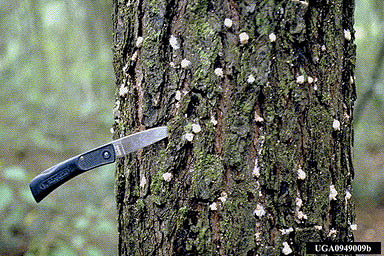Southern pine beetle
Dendroctonus frontalis
Natural History

Pitch tubes on loblolly pine
Photo credit: J. R. Meeker - Florida Division of Forestry
The southern pine beetle (Dendroctonus frontalis) is one of the most destructive insects in the South, causing hundreds of millions of dollars in damage each year. The southern pine beetle has not been as abundant in Florida as it has been in many southern states. During the 1990s, the southern pine beetle became more widespread in the state with significant damage occurring from the Tampa area northward. Populations of the insects can grow rapidly and reach epidemic proportions. Large number of trees can be killed very quickly in a single area and once an infestation is established there is no effective way to save the trees.
Southern pine beetles are frequently associated with the black turpentine beetles and the Ips beetles, less aggressive pine bark beetles common in Florida.
Initial attacks begin in weakened, injured, or dying trees but as beetle populations grow, they become capable of invading healthy trees. The female adult bores into the host tree's bark and begins constructing galleries in the phloem. The female gives off an odor and this odor, combined with the smell of resin from the host tree, attracts males and more females to the tree. This mass attack can easily overcome a tree's defense system. The beetles mate and females continue making their S-shaped galleries where they deposit their eggs. The eggs hatch and larvae emerge to feed on inner phloem and make their own galleries. Larvae tunnel towards the outer bark and enter the pupae stage. Immature adults emerge from the pupae stage and their bodies harden and darken. Finally, the beetles create an exit tunnel through the outer bark and fly to another tree to attack.
Host trees are damaged by the galleries created by the adults and larvae. The insects also introduce a fungus into the tree where they attack. This fungus discolors the xylem (blue stain) and aids the beetle in hastening the tree's death.
